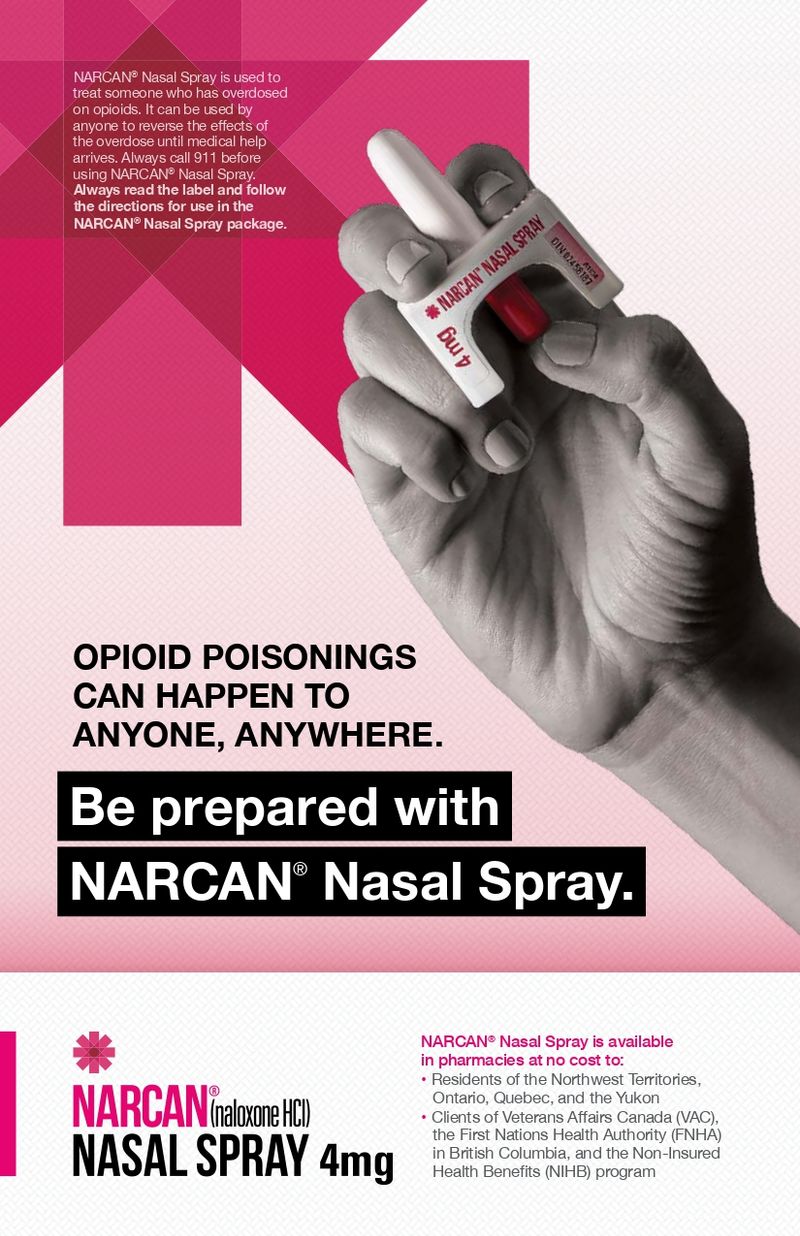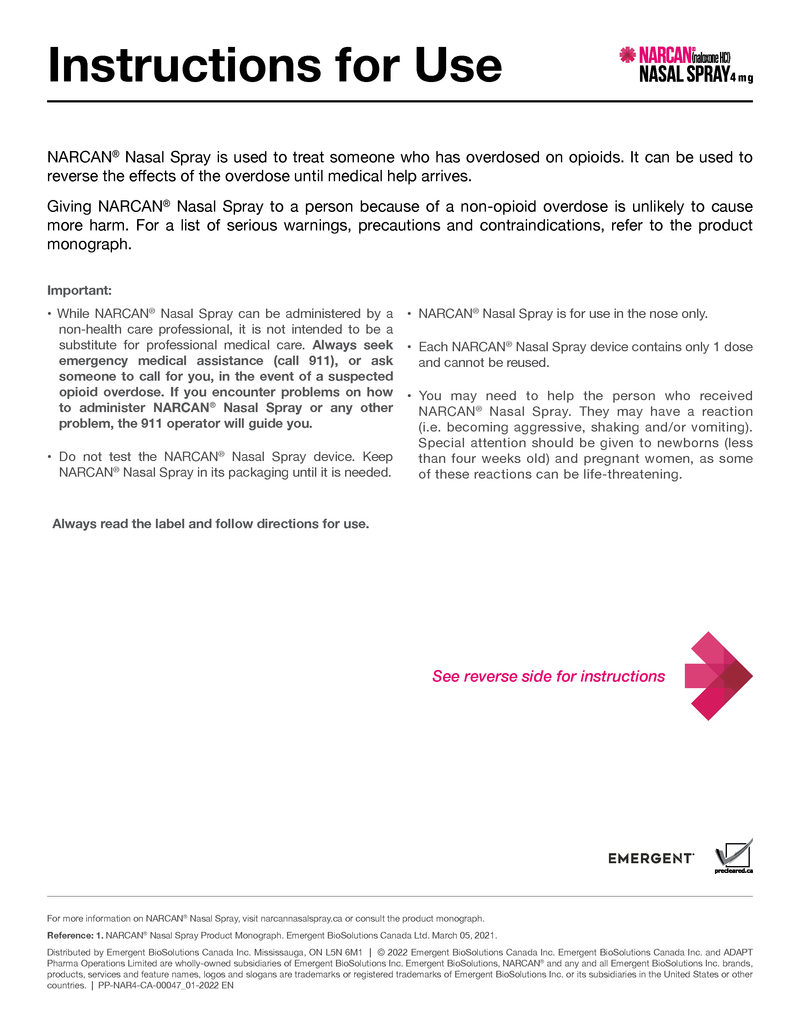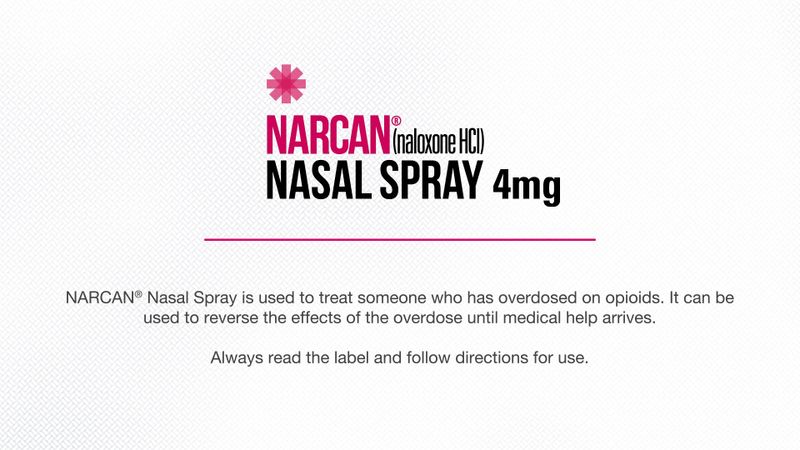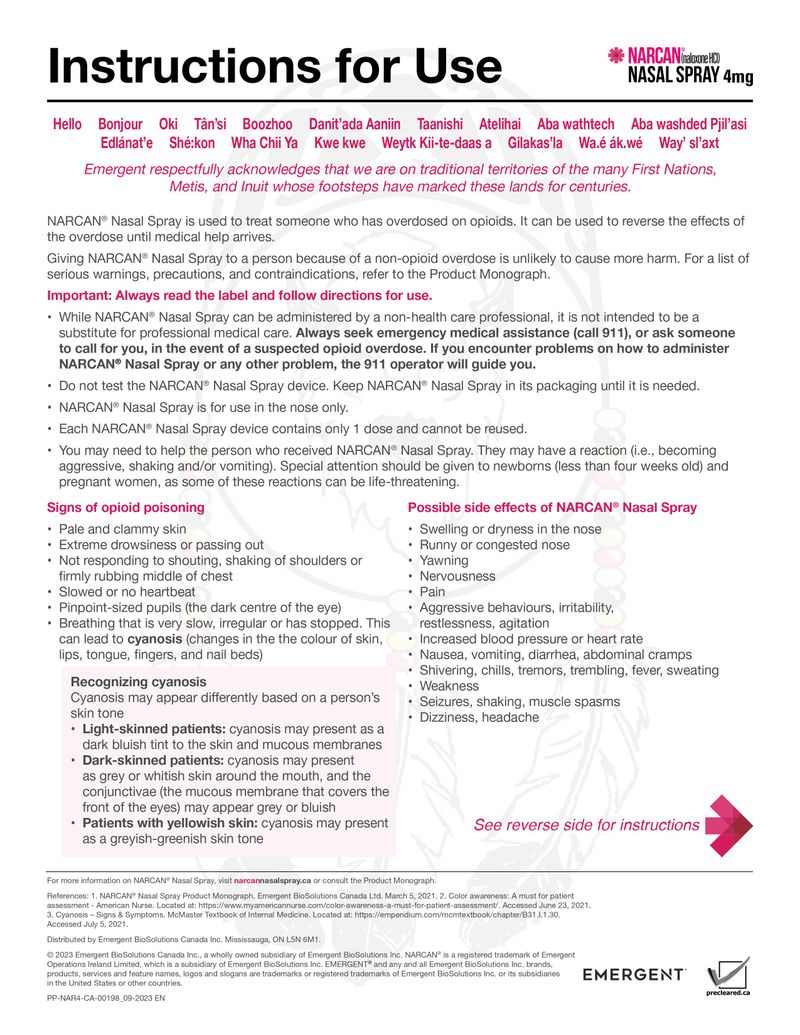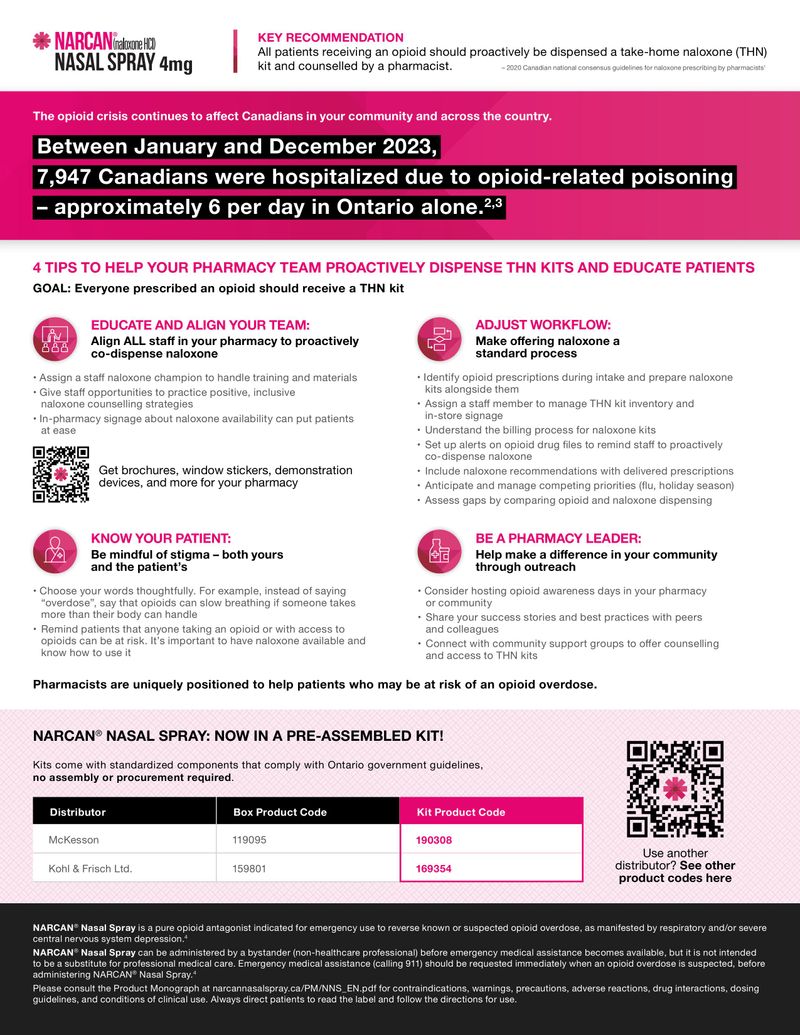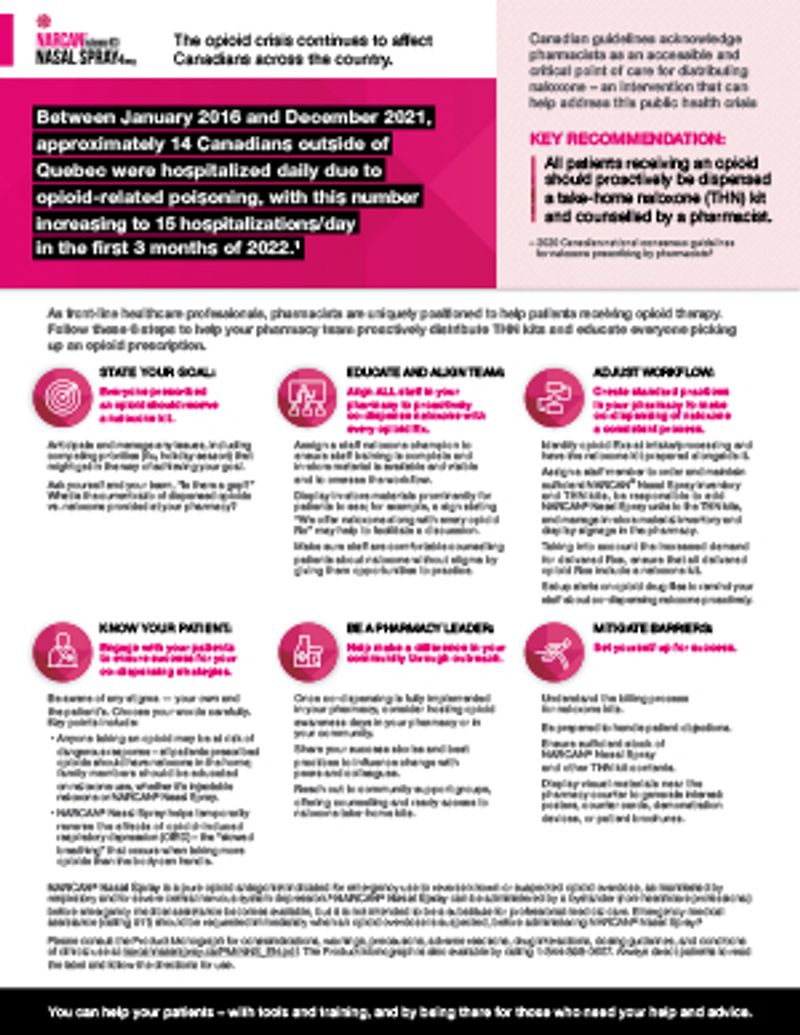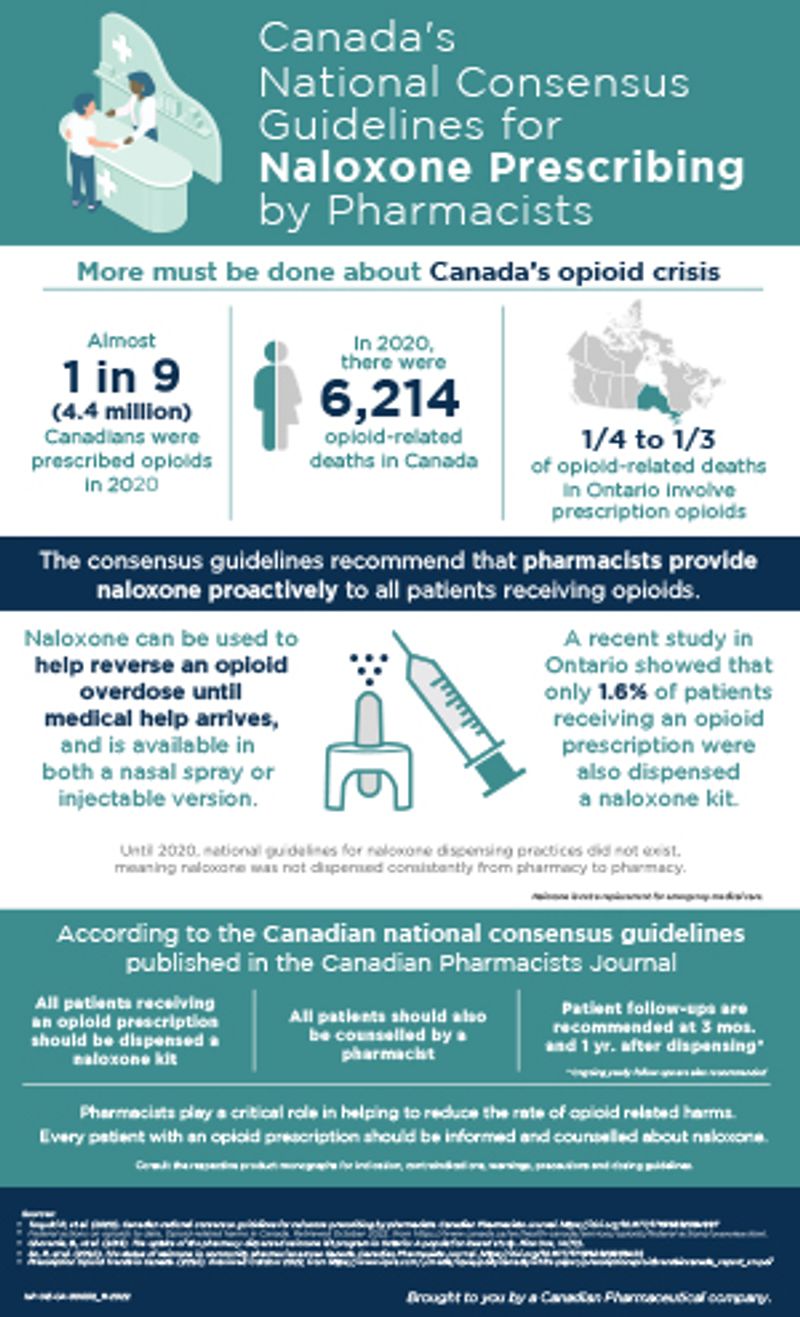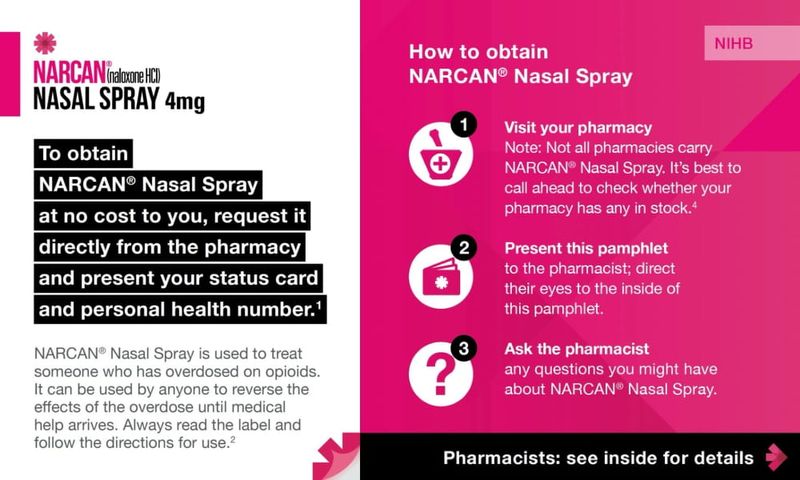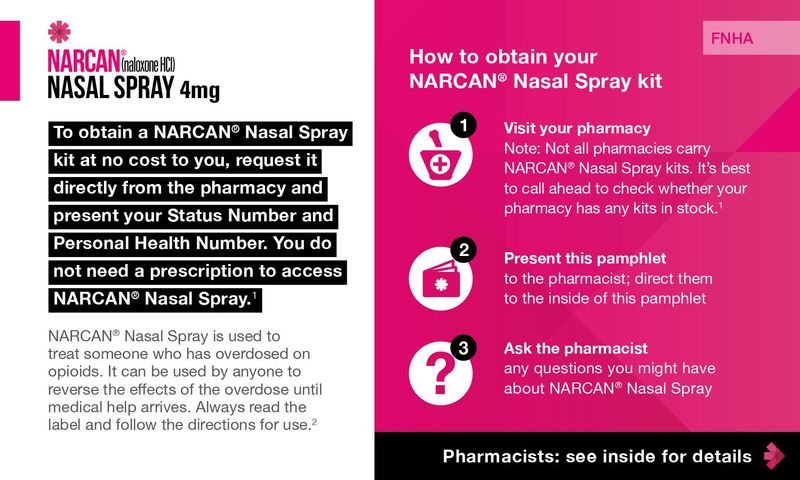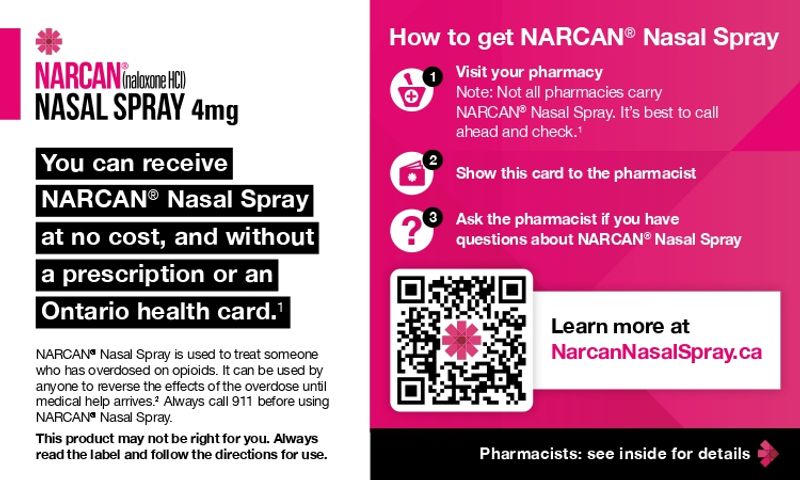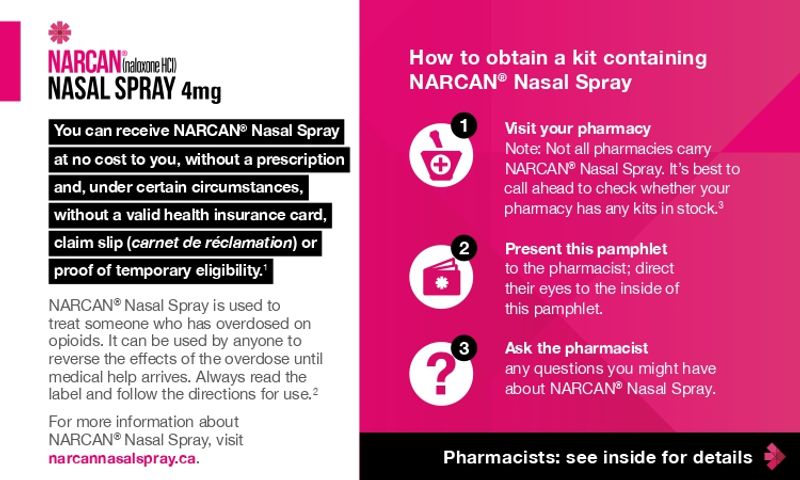
It’s not always obvious as to who might be at risk of an accidental opioid poisoning
The articles and videos below may inspire you to incorporate small changes into your practice that can help make a difference in the Canadian opioid crisis.
Indications and clinical use: NARCAN® NASAL SPRAY is a pure opioid antagonist indicated for emergency use to reverse known or suspected opioid overdose, as manifested by respiratory and/or severe central nervous system depression.
- NARCAN® NASAL SPRAY can be administered by a bystander (non-health care professional) before emergency medical assistance becomes available, but it is not intended to be a substitute for professional medical care. Emergency medical assistance (calling 911) should be requested immediately when an opioid overdose is suspected, before administering naloxone.
Do prescription opioids play a role in the crisis?
While prescription opioids offer benefits, they also come with some risks.2 In fact, in Ontario, 53% of patients hospitalized due to opioid-related reasons had an active opioid prescription.9 As the most accessible healthcare professionals in Canada, you can help make a difference.19




Biases and Preconceived Ideas
Everyone has bias—including patients and pharmacists.21,22 When it comes to opioid use, we may already have pre-conceived notions about the type of people who are at risk of opioid poisoning.7,20,23 This can have an impact on our conversations.22 Here are some ways to break-free from bias and tackle stigma.




Changing the Conversation Around Opioids
There are a few key words that come to mind when thinking about opioids: “overdose”, “accident”, “epidemic”, “addiction”, “death”. When talking to patients, your role as a pharmacist is to find a balance between the benefits and risks of prescription opioids, and to help keep the conversation positive.




Resources For Your Team
Here are some resources you may find helpful.
Patient Resources
Dispensing tools
National Consensus Guidelines
Discreet request cards
Always offer a take-home naloxone kit–available as either a nasal spray, like NARCAN® Nasal Spray, or an injection–to any patient receiving an opioid prescription.1,3
Safety information10
Indications and clinical use:
NARCAN® NASAL SPRAY is a pure opioid antagonist indicated for emergency use to reverse known or suspected opioid overdose, as manifested by respiratory and/or severe central nervous system depression.
NARCAN® NASAL SPRAY can be administered by a bystander (non-health care professional) before emergency medical assistance becomes available, but it is not intended to be a substitute for professional medical care. Emergency medical assistance (calling 911) should be requested immediately when an opioid overdose is suspected, before administering naloxone.
Contraindications:
Patients who are hypersensitive to this drug or to any ingredient in the formulation or component of the container.
Serious warnings and precautions:
- Call 911: Emergency medical assistance (calling 911) should be requested immediately when an opioid overdose is suspected, before using naloxone.
- Continued surveillance: Individuals with a satisfactory response to an initial dose of naloxone should be kept under continued surveillance.
- Aggressive reactions: Caregivers administering naloxone should be prepared to act in response to or assist the patient in cases of potential adverse reactions such as aggressive reactions, convulsions and vomiting. Special attention is warranted if naloxone is administered to a neonate or a pregnant woman.
Other relevant warnings and precautions:
- In opioid dependent people, naloxone may trigger an acute opioid withdrawal syndrome; this may be life-threatening in opioid dependent neonates
- Preterm labour or fetal distress in opioid dependent pregnant women
- Rebound opioid toxicity, including respiratory depression, following the temporary reversal of the opioid overdose
- Ineffective against respiratory depression due to non-opioid drugs
- Cardiovascular risks including rare cases of cardiac arrest, tachycardia and ventricular fibrillation
- Post-operative considerations including hypotension, hypertension, ventricular tachycardia and fibrillation, dyspnea, pulmonary edema and rare cases of cardiac arrest. Death, coma, and encephalopathy have been reported as sequelae of these events
- Convulsions or seizures
- Irritability and aggressive behaviour
- Gastrointestinal reactions including diarrhea, nausea, vomiting and abdominal cramps
- Use in nursing women has not been established
- Higher systemic exposure in geriatrics
For more information:
Please consult the product monograph at http://www.narcannasalspray.ca/PM/NNS_EN.pdf for important information relating to contraindications, adverse reactions, drug interactions, patient selection and dosing information.
The product monograph is also available by calling 1-844-898-0657.
Sign up for updates
Please leave your email address here to be notified about updates on information, resources, materials and links. You can unsubscribe at any time by clicking on the unsubscribe link at the bottom of our emails.
Frequently Asked Questions
Can NARCAN® Nasal Spray be used on pregnant women?
- NARCAN® Nasal Spray should only be used in pregnant women when clearly needed.10
Giving NARCAN® Nasal Spray to anyone who is physically dependent on opioids may induce an acute opioid withdrawal syndrome causing a reaction such as becoming aggressive, shaking and/or vomiting. You will need to pay special attention when giving NARCAN® Nasal Spray to a pregnant woman because some of these reactions may cause preterm labour or can be life threatening to the fetus. Emergency medical assistance (calling 911) should be requested immediately when an opioid overdose is suspected, before administering NARCAN® Nasal Spray.10
Please see the product monograph and patient information for a full list of warnings and precautions:
For health care professionals:
For patients: Can NARCAN® Nasal Spray be used on a child?
- Yes, it can, but there are a few considerations:
Newborns:
You may need to help the person who received NARCAN® Nasal Spray. The patient may have a reaction such as becoming aggressive, shaking and/or vomiting. You will need to pay special attention when giving NARCAN® Nasal Spray to a newborn who is less than four weeks old or a pregnant woman. Some of these reactions can be life-threatening for a newborn or a fetus. Emergency medical assistance (calling 911) should be requested immediately when an opioid overdose is suspected, before administering NARCAN® Nasal Spray.10
The pharmacist may recommend using an alternate form of naloxone in newborns or children under two years old. This is because smaller doses can be given with the injectable form of naloxone.10
Children:
When administering NARCAN® Nasal Spray in young children, the nozzle of the device may not fit inside the child’s nostril. In this case, make sure that the device nozzle forms a seal with the nostril before giving NARCAN® Nasal Spray.10
Please see the product monograph and patient information for a full list of warnings and precautions:
For health care professionals:
For patients: Can NARCAN® Nasal Spray be used past its expiration date?
- NARCAN® Nasal Spray should be used before the expiration date on the box. However, if only expired NARCAN® Nasal Spray is available in an overdose situation, it should be used.10
What are the withdrawal symptoms that occur when you use NARCAN® Nasal Spray? What should you be prepared for?
- NARCAN® Nasal Spray should be administered with caution to patients who are known or suspected to be physically dependent on opioids. In such cases, an abrupt reversal of opioid effects may precipitate an acute opioid withdrawal syndrome. The severity of such a syndrome will depend on the degree of physical dependence, the dose and potency of the opioid that induced the overdose, and the dose of naloxone administered.10
The signs and symptoms of an acute opioid withdrawal syndrome include, but are not limited to: body aches, pain, fever/pyrexia, sweating/hyperhidrosis, runny nose, sneezing, piloerection, yawning, weakness, asthenia, shivering, chills, tremor/trembling, convulsions/seizures, nervousness, restlessness, irritability, aggressive behavior, diarrhea, nausea, vomiting, abdominal cramps, increased blood pressure, and tachycardia. In the dependent neonate, signs also include excessive crying as well as hyperactive reflexes and the acute withdrawal may be life-threatening if not recognized and properly treated.10
Emergency medical assistance (i.e., calling 911) should be requested immediately when an opioid overdose is suspected. Monitor the patient for the development of the signs and symptoms of opioid withdrawal. Caregivers administering naloxone to any patient should always be prepared for potential reactions associated with acute opioid withdrawal syndrome and to assist the patient to minimize harm when experiencing these reactions. For example, a patient should be positioned in lateral decubitus to prevent choking if vomiting occurs; sharp or dangerous objects should be moved away in case of convulsions to protect the patient from injury, but the patient should not be restrained.10 How does reimbursement work? Can you give it to someone without ID?
- NARCAN® Nasal Spray is available at pharmacies in Ontario as part of the Ontario Naloxone Program for Pharmacies (ONPP), and in Quebec as part of the Program for Free Access to Naloxone and Certain Related Supplies implemented by the Ministère de la Santé et des Services sociaux.11,12
NARCAN® Nasal Spray is also available for Veteran Affairs Canada clients, Non-Insured Health Benefits (NIHB) program clients, and First Nations Health Authority (FNHA) clients in British Columbia.13-15
Patients can request NARCAN® Nasal Spray without providing a prescription or an ID, helping them protect their privacy.16- In Ontario, for anonymous patients or those without an Ontario health card, use the following information:11
First and last name: HARM REDUCTION
Gender: blank
DOB: 20000101
Proxy patient ID: 89999 999 91 - In Quebec, a health card may not be required to receive it; it can be supplied anonymously, especially in case of emergency.12,17
- In Ontario, for anonymous patients or those without an Ontario health card, use the following information:11
Do you need to call 911 if using NARCAN® Nasal Spray?
- Yes, NARCAN® Nasal Spray can be administered before emergency medical assistance becomes available, but it is not intended to be a substitute for professional medical care. Emergency medical assistance (calling 911) should be requested immediately when an opioid overdose is suspected, before administering NARCAN® Nasal Spray.10
How much time between doses does there need to be?
- Multiple doses of NARCAN® Nasal Spray may be required until emergency medical assistance becomes available.10
If the patient responds to the first dose of NARCAN® Nasal Spray but relapses back into respiratory depression before emergency assistance arrives, administer repeated doses of NARCAN® Nasal Spray as necessary. If the patient does not respond to the first dose of NARCAN® Nasal Spray after 2-3 minutes, administer repeated doses using alternate nostril as necessary.10 How do you order NARCAN® Nasal Spray kits?
- Orders for NARCAN® Nasal Spray can be made by calling Emergent BioSolutions Canada Inc. at 1-844-898-0657 or by emailing customerservicecanada@ebsi.com.
How many NARCAN® Nasal Spray kits can you hand out to a person?
- In Ontario, up to two NARCAN® Nasal Spray kits can be given to a patient at a time.11 In Quebec, up to four NARCAN® Nasal Spray kits can be given to a patient at a time.18
Is one dose of NARCAN® Nasal Spray sufficient to reverse an opioid overdose?
- Not always, some patients may need multiple doses. The requirement for repeat doses of NARCAN® Nasal Spray depends upon the amount, type, and route of administration of the opioid being antagonized.10
If the patient does not respond within 2-3 minutes to the first dose of NARCAN® Nasal Spray, administer an additional dose of naloxone every 2-3 minutes (if additional doses are available), using a new NARCAN® Nasal Spray device for each dose using alternate nostril, until the desired response is obtained.10
References: 1. Tsuyuki R et al. Canadian national consensus guidelines for naloxone prescribing by pharmacists. Canadian Pharmacists Journal. 2020;153(6):347-351. 2. Government of Canada. Canada’s Opioid Crisis. Available at: https://www.canada.ca/content/dam/hc-sc/documents/services/publications/healthy-living/canada-opioid-crisis.pdf(Open in a new window). Accessed July 27, 2021. 3. Ontario Pharmacists Association. Pharmacist clinical tool for initiating naloxone discussions. Available at: https://opatoday.com/wp-content/uploads/Practice/Tools/Naloxone/Pharmacist-Clinical-Tool-for-Initiating-Naloxone-Discussions.pdf(Open in a new window). Accessed July 27, 2021. 4. Government of Quebec. Risks of opioid overdose. Available at: https://www.quebec.ca/en/health/advice-and-prevention/alcohol-drugs-gambling/risks-of-opioid-use(Open in a new window). Accessed July 27, 2021. 5. Dowell D, Haegerich TM, Chou R. CDC guideline for prescribing opioids for chronic pain—United States, 2016. MMWR Recomm Rep. 2016;65(1):1-50. 6. U.S. Department of Health & Human Services. U.S. surgeon general’s advisory on naloxone and opioid overdose. Available at: https://www.hhs.gov/surgeongeneral/priorities/opioids-and-addiction/naloxone-advisory/index.html(Open in a new window). Accessed July 27, 2021. 7. Dassieu L, Heino A, Develay É, et al. “They think you’re trying to get the drug”: Qualitative investigation of chronic pain patients’ health care experiences during the opioid overdose epidemic in Canada. Canadian Journal of Pain. 2021;5(1):66-80. 8. Government of Canada. Opioid overdose. Available at: https://www.canada.ca/en/health-canada/services/substance-use/problematic-prescription-drug-use/opioids/overdose.html(Open in a new window). Accessed July 27, 2021. 9. Gomes, T et al. Comparing the contribution of prescribed opioids to opioid-related hospitalizations across Canada: A multi-jurisdictional cross-sectional study. Drug and Alcohol Dependence. 2018;191:86-90. 10. NARCAN® Nasal Spray Product Monograph. Emergent BioSolutions Canada Ltd. March 5, 2021. 11. Ontario Ministry of Health and Long-Term Care. UPDATED Executive Officer Notice: Ontario Naloxone Program for Pharmacies. August 23, 2024. https://www.ontario.ca/files/2024-08/moh-executive-officer-notice-en-2024-08-23.pdf(Open in a new window).12. Quebec: Régie de l’assurance maladie. Programme de gratuité du médicament naloxone et de certaines fournitures. 2017. Available at: https://www.ramq.gouv.qc.ca/SiteCollectionDocuments/professionnels/infolettres/2017/info235-7.pdf(Open in a new window). Accessed July 27, 2021. 13. Government of Canada. Naloxone Nasal Spray now available to First Nations and Inuit through Non-Insured Health Benefits program. Available at: https://www.canada.ca/en/indigenous-services-canada/news/2018/04/naloxone-nasal-spray-now-available-to-first-nations-and-inuit-through-non-insured-health-benefits-program.html(Open in a new window). Accessed July 27, 2021. 14. Veteran Affairs Canada. NARCAN NASAL SPRAY 4MG/0.1ML. Available at: https://www.veterans.gc.ca/eng/financial-support/medical-costs/treatment-benefits/poc10/search/form_detail/02458187(Open in a new window). Accessed July 27, 2021. 15. First Nations Health Authority. Nasal Naloxone Listed as a Health Benefit for First Nations in BC. Available at: https://www.fnha.ca/Documents/FNHA-Nasal-Naloxone-Fact-Sheet.pdf(Open in a new window). Accessed July 27, 2021. 16. Government of Canada. Naloxone. Available at: https://www.canada.ca/en/health-canada/services/substance-use/problematic-prescription-drug-use/opioids/naloxone.html(Open in a new window). Accessed July 27, 2021. 17. Quebec: Régie de l’assurance maladie. Instructions de facturation pour le remboursement du médicament naloxone et de certaines fournitures. 2017. Available at: https://www.ramq.gouv.qc.ca/SiteCollectionDocuments/professionnels/infolettres/2017/info256-7.pdf(Open in a new window). Accessed July 27, 2021. 18. Quebec: Régie de l’assurance maladie. Ajout du vaporisateur nasal NarcanMC et de certaines fournitures au Programme de gratuité du médicament naloxone et de certaines fournitures. 2018. Available at: https://www.ramq.gouv.qc.ca/SiteCollectionDocuments/professionnels/infolettres/2018/info046-8.pdf(Open in a new window). Accessed February 24, 2022. 19. Canadian Pharmacy Association. Pharmacy in Canada. Available at: http://www.pharmacists.ca/cpha-ca/assets/File/pharmacy-in-canada/Pharmacy%20in%20Canada.pdf(Open in a new window). Accessed July 27, 2021. 20. Antoniou T, Pritlove C, Shearer D, et al. A qualitative study of a publicly funded pharmacy-dispensed naloxone program. International Journal of Drug Policy. 2021;92:103146. 21. Steinhauser K. Everyone is a little bit biased. American Bar Association. Available at: https://www.americanbar.org/groups/business_law/publications/blt/2020/04/everyone-is-biased/(Open in a new window). Accessed August 3, 2021 22. FitzGerald C, Hurst S. Implicit bias in healthcare professionals: A systematic review. BMC Medical Ethics. 2017;18(1):19. 23. College of Pharmacists of British Columbia. A Message from Our Board Chair: Understanding How Stigma Can Impact Patient Care. March 23, 2018. Available at: https://www.bcpharmacists.org/readlinks/message-our-board-chair-understanding-how-stigma-can-impact-patient-care(Open in a new window). Accessed July 27, 2021. 24. Public Health Ontario. Opioid Mortality Surveillance Report: Analysis of Opioid-Related Deaths in Ontario July 2017–June 2018. June 2019. Available at: https://www.publichealthontario.ca/-/media/documents/O/2019/opioid-mortality-surveillance-report.pdf(Open in a new window). Accessed July 27, 2021. 25. Healthline. Tylenol with Codeine Overdose. Available at: https://www.healthline.com/health/acetaminophen-and-codeine-overdose(Open in a new window). Accessed July 27, 2021. 26. Mayo Clinic. What are opioids and why are they dangerous? Available at: https://www.mayoclinic.org/diseases-conditions/prescription-drug-abuse/expert-answers/what-are-opioids/faq-20381270(Open in a new window). Accessed July 27, 2021.
Distributed by Emergent BioSolutions Canada Inc. Mississauga, ON L5N 6M1.
© 2024 Emergent BioSolutions Canada Inc., a wholly owned subsidiary of Emergent BioSolutions Inc.
NARCAN® is a registered trademark of Emergent Operations Ireland Limited, which is a subsidiary of Emergent BioSolutions Inc.
EMERGENT® and any and all Emergent BioSolutions Inc. brands, products, services and feature names, logos and slogans are trademarks or registered trademarks of Emergent BioSolutions Inc. or its subsidiaries in the United States or other countries.
You are about to leave StoppingTheStigma.ca
A service brought to you by Emergent BioSolutions Canada Inc. Emergent BioSolutions takes no responsibility for the content of any third-party websites and makes no representation as to the accuracy or completeness of any information available through this or any subsequent link.
